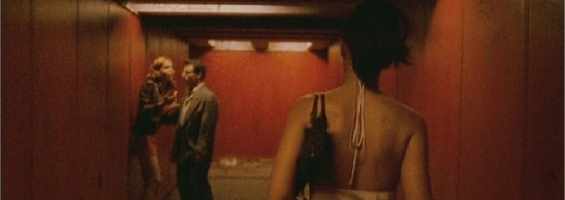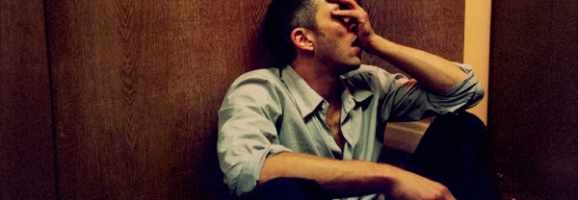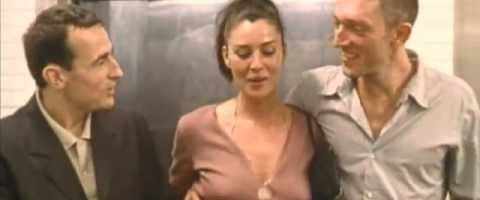Life is ‘Irreversible’: Editing, Camera Techniques, and Chronology in Noe’s Film

Irreversible is a film directed by Gaspar Noe about two men, Marcus and Pierre, who team up to find the man who raped Alex, Marcus’s girlfriend and Pierre’s ex-girlfriend. The whole film takes place in one terrible night that will change the characters’ lives forever. Were the characters’ meant to get to this very point from the beginning? Could they have been saved? Is revenge ever helpful? There are so many questions that this movie brings up, but one thing we do learn for certain is that we cannot go back.
The film goes from the end to the beginning. If that is not strange enough, each scene has zero cuts. The camera movement is jerky, dizzying, hectic, and does not stop. Though unnerving at first, the editing and chronology of the film are directly related to the questions and themes of the movie. One description of the film says that it is a “disturbing look at fate and destiny” and that it “pushes the envelope of human emotions.” Irreversible is definitely disturbing, and if it is a look at destiny and fate then its editing and chronology make perfect sense (or as much sense as a movie like this can make).
The film begins with a swirling shot moving up a building, then into an unkempt, dimly lit room. A naked man sits on a bed and says to his friend “You know what? Time destroys all things.” At this point there is no sign the story is going backwards, but it can be noted that there are not cuts thus far. The camera is handheld, and does not stay upright. It turns back and forth to ninety degree angles and back. It gets close up to the men’s faces, bodies, cigarettes, and the bed they are sitting on. In fact, the camera continuously moves without really picking a single focus. It is like this for the first half of the movie. The other man in the scene says “there are no bad deeds, just deeds.” The naked man answers “Gotta fight. Gotta live. Go on fighting. Go on living.” The camera movement reflects this because it, too, just keeps going on. It is never dormant, it keeps moving to the next picture without stopping. No matter what bad deeds or good deeds someone does, life does not stop for it. After listening to their short conversation, we hear an ambulance. One man asks what the noise was, and the other answers that the people downstairs in “The Rectum” are always causing trouble. The phrase “They are always causing trouble in ‘The Rectum'” sounds extremely out of place at this point, but it makes more sense in the upcoming scenes. The camera leaves their room to go outside where we see a man being taken away on a stretcher and another man who leaves in a police car.

The camera keeps rolling for our main characters as well. The next scene is so dizzying it is hard to watch. It is dark with dim, red lighting. The camera spirals down a hall, and the music, if it can be called music, is a repetitive, robotic whining sound. As the camera spirals, we catch glimpses of graphic sex between men. In the previous scene we were only introduced to the main characters by watching them being taken away in an ambulance and a police car. As the story moves backwards, the second scene shows what the characters were doing right before things ended badly. The camera trails Marcus, who previously left on the stretcher, as he is looking for a man named “The Tenia” in this gay S&M club. Pierre, who left in the police car, tries to convince him to leave, and says “Marcus, come back! I’m not gonna save you!” But Marcus keeps going, and the camera keeps following him. This definitely becomes one of the most difficult scenes to watch. While it is hard to see precisely where we are heading because of the camera movements, we too clearly see the sex going on and hear the disturbing moaning, all while Marcus searches for The Tenia. He and his friend Pierre do find the Tenia, and Pierre flattens his head with some blunt object (but did he have the right guy?). What is interesting is it is unclear why he is looking for the Tenia yet, or why he wanted him dead, but the reason has already happened. It is set in stone. It may be a mystery to the audience, and at one point it was a mystery to the characters, but the way this story is told, in reverse, it reminds that you cannot change what is going to happen next.
Because this is only the second scene of the movie, it is not easy to make these deep and intricate connections watching it the first time. The first time around, it is difficult to focus on the artistry and acknowledge the thought that went behind this film because the first half of the movie is so violent and disturbing it is hard to think about anything else. However, it is important to note that so much has already happened in the second scene that it is arguable that it is the most crucial, although it would not be realized until the end. The whole scene embodies the most important themes of the movie: fate, destiny, and how it cannot be stopped. “The camera keeps rolling.”
Another vital scene would be when Alex is raped. Unlike the previous scenes, the camera is still, and captures the rape from the floor where it is happening. It takes place in an all red underpass. The camera stays in its place about a yard away from them. There are no close ups of Alex’s or the rapists face (The Tenia), the camera just watches. If there had been cuts in this scene, or even if the camera had moved a little bit more, it would have taken the audience out of the movie. By having the least amount of movement possible, it made it so the viewers were right there watching this happen in real life, like someone sneakily watching from around the corner. Life does not have any cuts, it does not give you a chance to catch your breath or look away, which is something this scene shows in an extremely uncomfortable way.

The first half of this movie and the second half are like watching two completely separate movies altogether. Even though things learned in the second half make some of the first half even worse, it has a different mood. It is hard to share the mood knowing what is about to happen to all the characters, but it is different. We actually learn about the characters in the second half. We see them happy and in their normal lives. Just like the first half, each scene has no cuts. The camera follows our characters to a party, it watches them have a conversation on the subway, and sees them at home. It would all be seemingly ordinary if it did not have the shadow of the previous scenes over it, which is another important effect of the film moving in reverse. After the final scene, there is no feeling of conclusion, it feels like this movie could just keep going and going, although it probably would not take away the disturbed feeling the viewer has.
Even though it is difficult to watch and the themes are not necessarily positive ones, you cannot deny the uniqueness of this film and how cleverly the camera techniques and minimal editing added to the themes and the film as a whole. It would have been a completely different movie had there been close-ups, tripods, and a bunch of cuts during each scene. Without all that, it was real. If the movie had not gone backwards, the message that “we cannot go back” would not have been blatant. As deeply discomforting as it is, this film was well done. The actors could not have done better, the story line was different and evoked strong reactions, the chronology forced you to think, and the cinematography and editing were perfectly done to get the film’s points across. The only question left is how far is too far when it comes to pushing the boundaries of film?
What do you think? Leave a comment.











Personally I feel that the message of the movie is a positive one. To make you want to live life to its fullest, because anything can happen, and after all, your time is limited.
Unfortunately, I’m not sure you can pull a positive message (or a negative message) from this film…it is quite neutral. I think the film was saying you can’t really make anything out of life; that it is completely out of control and there is no free will. The director leaves hints and clues throughout the entire film, as you mentioned ,the “there’s no bad deeds, just deeds” line is one of them but there is also the book that Alex was reading stating that the past, present, and future are fixed and exist all at once. Then there is the concept of the newborn child and the poster of the fetus from 2001 which corroborates the idea of past, present, and future all existing at once. The fact that the wrong guy was killed and Tenia got away with it when he was standing just inches away from Marcus (even offering him a smoke) kind of shows where the director was going with all this…there is no justice in this world. Sometimes good things happen to bad people and unfortunately, sometimes bad things happen to good people. We as humans try to make sense of this by rejecting this notion, we are vindictive and indignant when we are wronged (Marcus seeking revenge) but the fact of the matter is, the universe doesn’t operate this way (wrong guy killed, Tenia getting away). There is no good or bad, there is just “isness”. Whatever happened in the past, is happening now, and is going to happen was meant to be that way. Its not good or bad, it just is.
That’s a pretty good take on it. You’re probably right about Goe wanting the message to be “everything just is,” however he is pretty negative. If you’ve seen his film “I Stand Alone” you’d have to agree haha. That was was so disturbing I couldn’t watch the whole thing (I only saw the last scene in a film class).
I think that’s cool that you can get something positive out of this movie! I was hard for me as it was so graphic, I think.
A new genre definitely needs to be given for movies like these. It’s definitely not horror and this movie isn’t even a thriller. Like The Piano Teacher, The Kill List or the original Straw Dogs, I think this can best be described as a Disturbing Drama. I’ve only seen it once and can’t get myself prepared to watch it again.
Your experience with these films mirror my experience exactly. I have the DVD also but haven’t watched it and now it’s on Netflix. I’m trying to get up enough nerve to watch it again.
I’m an horror movie maniac and watch just about everything but about 10 years ago I meandered towards this genre of films With Irreversible , that was the first time in my life where I was depressed for about a week from a movie.
Martyrs is the same, except the first part does seem more like a horror film. The second half is unbearable to watch again.
I didn’t like 29 palms the first time I watched it, but then I saw Anti-Christ and understood 29 palms more.
I’m gonna have to watch Martyrs and 29 Palms, I’ve never heard of them! And I know exactly what you mean by being depressed for a week because of a film haha. That’s how I felt after watch only one scene of I Stand Alone (I had to watch the final scene in a film class). Anti-Christ was also pretty disturbing. It didn’t affect me quite like the others but after watching it me and my friend kind of didn’t know what to do next, haha.
I don’t blame you for having a hard time watching it a second time. It was hard for me as well. You’re also right about the genre! It’s too unique to really put it a common genre like horror or a typical drama
The original Funny Games, kind of fits that as well. That movie made me so angr.
Also Visitor Q.
Whoever wrote the English translation did a pretty poor just of it, or as I read in the subtitles, uncareful.
I wound up giving up on it half-way through because the photography was giving me motion sickness (something I don’t get either on a rough sea or a bumpy airplane ride). Pretty impossible to appreciate any artistic merit it might have had when you are getting an upset stomach. And the fire extinguisher at the end (beginning) looked too inflatable to me to suspend disbelief. I never made it to the infamous rape scene so I can’t comment on that. Screw this. I figured out years ago that life is too short to watch bad movies. You can’t get those hours back.
Haha, I like you’re way of thinking. I guess even though it’s upsetting sometimes, I like a messed up movie now and then, if only for the artistic merit. I think everyone has a line that they draw though.
To this day, I’m not even sure how I feel about it.
Irreversible is definitely a polarizing film.
The rape scene was horrific but the thing that really got to me was when you see another man enter the tunnel, sees the rape occurring and simply turns around and leaves.
That was a devastating critique on society as a whole and that scared me on a very real level, sorry to get political here but everyone has been so, for the lack of a better word, neutered and conditioned by the government to believe that only elected officials ie cops, can enforce the law that most people are completely apathetic or ambivalent about anything, their train of thought, it’s not my problem, that’s what the cops are for, I’ll just keep my head down and I’ll be right.
In other words, if the cops aren’t around, no one is going to do anything and I feel like this kind of apathy is what allows a lot of criminals to thrive in the first place, society as a whole, has lost their collective backbone, most people have the attitude of just keep your head down and no one will bother you but that’s the problem in the first place.
People have too much faith in the government to protect them and not enough courage to protect themselves and others.
I actually thought the same exact thing when that random person walked by! I will say though, I think things are a bit different in Europe as far as trying to “save people.” I’m not sure if it’s the same in France, but I know in the UK if you see someone get attacked that you are encouraged to run and get help. I doubt anyone would get in trouble for trying to help, but for some reason they say to just get the police as fast as you can. I’m not entirely sure why. Not that you’re not right about your point…
It’s just a highly overrated movie.
I got sea-sick after watching two scenes of “disorientating camera motions” and strobe lights.
Way for Noé to keep people from watching his movies…
I can’t even blame you!
Everything is flawless, and it pulls no punches. Gaspar Noe is a genius.
It was an upsetting movie on many levels, but I would have to agree 🙂
Gaspar Noé’s style remains distinct from any other director in cinema.
i think there’s a beauty to its ugliness. a harsh and chaotic realism.
Interesting description, and I agree!
This movie totally disrespects its audience, both visually and aurally.
you totally have every right to think that.
This film made me wince and almost turn it off on several occasions. And now everytime I hear french sirens I think of this movie. But it is a fantastic piece of filmmaking and Noe deserves credit for almost creating an entire new genre with this film.
I see this movie as belonging to the tradition of French art cinema, deeply influenced by the movies of Gaspard Noe, especially Seul Contre Tous.
This was a really great film. One of the few that was nauseating to watch, but didn’t allow you to look away.
Gasper noe tells Life is irreversible…And made movie in reversible… Making people to watch once and not reversible….Bt movie impression makes in some people mind reversible and irreversible…..
Let’s admit that when you say: “if the camera had moved a little bit more, it would have taken the audience out of the movie” is just speculation.